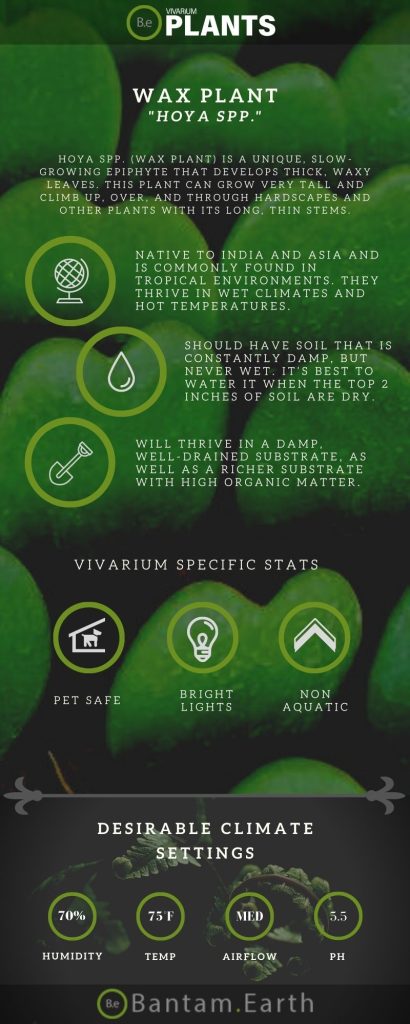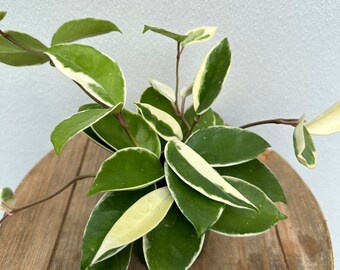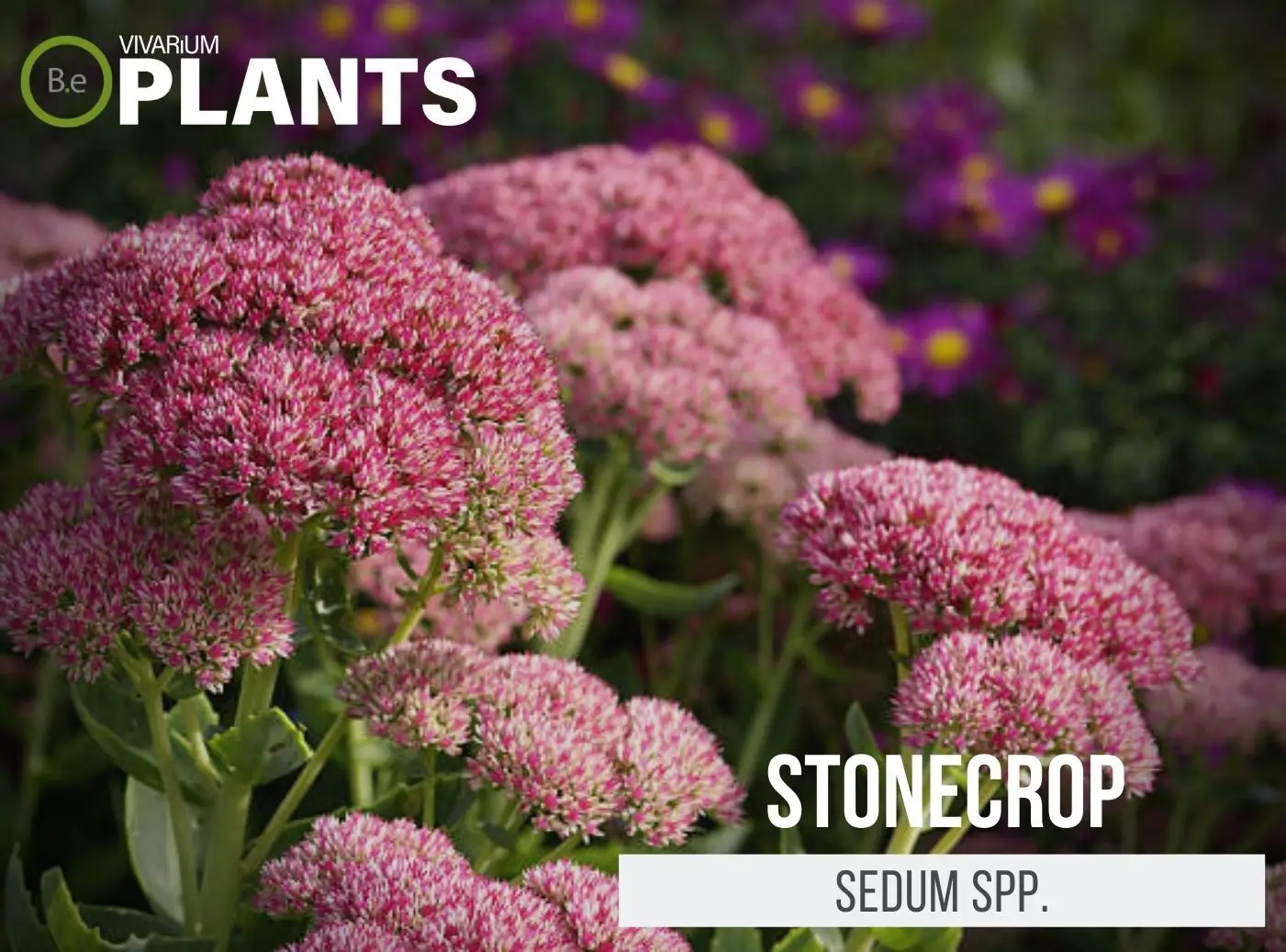If you are looking to add a touch of exotic beauty to your terrarium, look no further than the Hoya carnosa, commonly known as the Wax Plant.
This delightful succulent is a popular choice due to its low maintenance and interesting look, as well as its ability to thrive in vivariums.
From its long and glossy leaves to its unique wax–covered buds, this is a surefire way to give life to any terrarium.
Read on to learn more about this amazing plant and what makes it a great choice for your enclosure.
| Quick Stats: | |
|---|---|
| Scientific Name | Hoya Carnosa |
| Common Name | Wax Plant, Porcelain Flower, Hindu Rope Plant, Honey plant |
| Family Name | Apocynaceae |
| Habitat | Terrestrial |
| Temperature | 65°F to 85°F |
| Height | 1 to 4 feet |
| pH | 5.0 to 6.0 |
| Lighting | Bright, indirect |
What is Wax Plant?
Hoya carnosa is a unique, slow-growing epiphyte that develops thick, waxy leaves.
This plant can grow very tall and climb up, over, and through hardscapes and other plants with its long, thin stems.
The bright green leaves and red stamen of this plant give it a special character and a very lush feel to your enclosure.


Wax Plant Facts
The wax plant can grow up to 4 ft and needs support when planted in a vivarium.
This plant’s long, thin stems are great for wrapping around rocks, branches, and other plants to create a dense, cascading look.
It will benefit from trimming if it gets too unwieldy as new growth will fill in the space quickly.
Along with regular trimming, it is also beneficial to gently wipe its leaves with a damp cloth to keep it looking clean.
Description
The wax plant is an epiphytic species with thick, waxy leaves that grow in bunches.
This plant has thin stems that can climb up, over, and through hardscapes. Its stems become interwoven to form dense foliage.
Its leaves are 3-6 inches long and are bright green, almost succulent-like in texture.
The underside of the leaves will also have a slight shade of purple.
Its flowers once blooming have a star-like shape and depending on the species, can range in color from white, pink, yellow, or orange.
Habitat
The wax plant is native to India and Asia and is commonly found in tropical environments.
They thrive in wet climates and hot temperatures, although they can adjust to environments of lower light and cooler temperatures with proper care.
pH Preference
As an epiphyte, wax plants can survive in a wide range of pH levels, with a preference between 5.0-6.0.
It’s best not to fluctuate the levels drastically and look to maintain a consistent range.
Vivarium Type
The wax plant is quite an easy-going species. With that in mind, it will not be too complicated when it comes to choosing the type of enclosure it is grown in.
It is best to try and replicate the plant’s natural habitat as much as possible.
Doing so will make it easier to provide this succulent plant with its basic needs.
The proper setup and theme of the enclosure will make a big difference to the overall look and health of the plant.
Here are recommended vivariums it will do well in:
-
- Terrariums – Fully terrain-based enclosures with little to no aquatic features.
Vivarium Placement
Wax plants should be planted in the background of the vivarium, due to their natural habit.
They do best when trained around structural items like rocks and driftwood, especially in a more vertical environment.
It’s important to give it enough space for its stems, as well as adequate support to grow.
Substrate
Wax plants will thrive in a damp, well-drained substrate, as well as a richer terrarium substrate with high organic matter.
Any type of soil can be used, as long as it can provide enough moisture to the roots and provide good soil drainage.
Lighting
The wax plant loves bright, indirect terrarium light. When placed indoors, it will do best with LED lights or fluorescent bulbs, at least 4-5 hours a day.
It should not be in direct sunlight or any light that can potentially burn its leaves.
Buy Wax Plant
When it comes to buying wax plants, there are a few things to keep in mind.
Making sure the plant is healthy when purchased is essential for its success in a vivarium.
Vegetation that is already in poor conditions will have a very hard time adjusting to new environments.
Click the image below to find out more about the current price and other relative info about this plant.
Wax Plant Care and Propagation
This plant is easy to propagate!
Taking right-sized cuttings of 4-6 inches and planting them into moist soil will yield a healthy plant quickly.
Give the cuttings plenty of water initially and once rooted, reduce the amount of water given.
How to Grow
Hoya carnosa is a slow-growing epiphytic species that can take several months to establish its root system and stand upright.
When planted in the substrate, water it from the base and avoid the leaves.
Once acclimated, give it more water and fertilize occasionally for a more lush look.
In order for the plant to reach its full potential, it will benefit from an environment that mimics its native tropics.
Watering
Wax plants should have soil that is constantly damp, but never wet. It’s best to water it when the top 2 inches of soil are dry.
When spraying or misting this plant, make sure to avoid getting its leaves and flowers wet as this could lead to rotting.
Plants Similar to Wax Plant
Adding diversity to an enclosure is key to an aesthetically pleasing setup.
Try mixing up the look of your vivarium with different flora that can easily co-exist in the same environment.
Furthermore, if for some reason you find the wax plant hard to acquire or would like to consider something similar to this plant…
Here are other plants you might find will do well with or in the place of Hoya carnosa:
Conclusion
The wax plant is an excellent epiphytic plant for vivariums that provides dense foliage for a thicker, more lush look.
Its bright, star-like flowers really make it one of the show-stopping terrarium plants for any enclosure.
With the correct water and light, this plant can grow into a beautiful nook. Stick to misting the base and you will have a happy, healthy plant!
Frequently Asked Questions
The wax plant, or Hoya spp., is an evergreen perennial that can be grown both indoors and outdoors. When grown indoors, the wax plant needs bright, indirect sunlight and should be kept in a warm, humid environment. Outdoors, wax plants should be grown in a partially shaded area and should be protected from too much direct sunlight.
Yes, the wax plant is a succulent. It is a member of the Apocynaceae family and is native to India and China. The plant is drought tolerant and can store water in its leaves and stem, making it an ideal choice for gardeners looking for a low–maintenance succulent.
Wax plants prefer bright, indirect sunlight and should not be placed in direct sun. They can tolerate partial shade, but will not bloom if they are in full shade.
To get your wax plant (Hoya carnosa) to bloom, be sure to give it bright, indirect sunlight and a humid environment. Keep the soil evenly moist, but not soggy, and fertilize every two weeks during the growing season. Once the plant has matured, you can encourage flowering by reducing the amount of water and fertilizer and giving it cooler nighttime temperatures.
Yes, trimming your wax plant is recommended. Trimming stimulates new growth and helps keep the plant looking neat and full. To trim, use sharp scissors or shears to cut back the long stems at the desired length. For a fuller bushier look, trim back stems to just above a leaf node.




